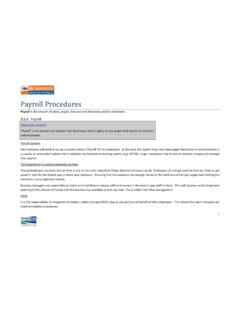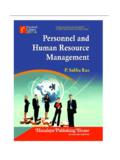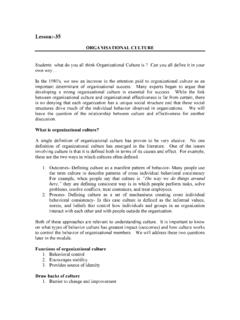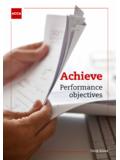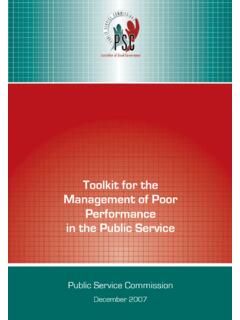Transcription of Change Management Process - Indigenous Business Australia
1 1 Change Management Process Change Management Process 1. Introduction This policy outlines [Your Company] s approach to managing Change within the organisation. All changes in strategy, activities and processes could result in changes in HSE risks. These risks need to be identified and assessed as part of the Change Management Process . 2. Definition of Change Management Change Management means defining and adopting corporate strategies, structures, procedures and technologies to deal with changes in external conditions and the Business environment. 3. Examples of Change Management All organisations need to deal with Change events.
2 Successful organisations are able to manage Change in a coherent manner and are able to generate the most benefit from changes and improvements to the way they do Business . A company such as [Your Company] is likely to deal with a number of different types of Change events. These could include: Changes in scale Where [Your Company] wins a large contract or opens a new Business line there will be a need to Change the way the Business works due to the increasing size of the organisation ( increases in employees, need for new premises, need for additional vehicles, changes in Management structures etc.)
3 Changes in personnel A more common Change event that all organisations will face from time to time is the need to adapt to changes in the personnel in key positions within the Business . For example, a Change in supervisor may Change team dynamics whilst a Change in accountant could include the risk of losing significant corporate knowledge. Changes in technology Where there have been improvements in technology ( communications, IT or equipment) there will be a need for [Your Company] to update their systems and train their employees to effectively manage the Change . Changes in service offerings In circumstances where [Your Company] was to Change the Business lines that we service then there will be a need to manage a Change Process through training existing staff, recruiting additional staff, updating the Business plan and potentially investing in new equipment and marketing literature.
4 Legislative Change Changes in laws and regulations could have a significant impact on how [Your Company] goes about undertaking its work. 2 4. HSE implications of organisational Change All changes in scale, personnel, technology, strategy and processes could result in changes in HSE risks. These risks need to be identified and assessed as part of the Change Management Process . Some examples of how Change may impact risk are outlined below: HSE risks - Changes in scale Where there will be a need to Change the way the [Your Company] works due to the increasing size of the organisation there may be additional HSE risks that need to be considered due to recruitment and induction of additional staff, conducting operations in new premises; use of new vehicles or equipment or changes in Management structures or reporting lines.
5 HSE Risks - Changes in Personnel Where there are changes in personnel there may be HSE risks associated with a lack of knowledge of the new staff of the correct safety procedures and protocols. Indeed, there may even be risks associated with the safety culture that these new employees may bring with them. HSE Risks - Changes in technology Investment in new processes or equipment can bring HSE risks where personnel are not trained or experienced in the use of the new equipment / technology. HSE Risks Service Offerings Changes in the range and nature of services offered by [Your Company] would bring additional HSE risks due to the new activities that staff must undertake so as to provide these services.
6 Process for assessing HSE risks associated with Change Management The control Process for assessing and mitigating risks associated with Change Management are the same as those in place for other workplace HSE risks. These are as follows: Eliminate the hazard from the workplace altogether. If a risk cannot be eliminated, try to substitute it with something that has a lower risk. Isolate the problem - this is often done by the use of separate purpose-built rooms, barricades, or sound barriers. Re-design equipment, work processes or tools to reduce or eliminate the risk. Administrative controls include appropriate training, written work procedures, adequate supervision, signage, maintenance of plant and equipment, or limitation of exposure time.
7 5. Key elements in successful Change Management The key elements in [Your Company] s approach to Change Management include: Planning: developing and documenting the objectives to be achieved by any Change and the means to achieve it. Defined Governance: establishing appropriate organisational structures, roles, and responsibilities for the Change that engage stakeholders and support the Change effort. 3 Committed Leadership: ongoing commitment from the leadership of [Your Company] and across the organisation to guide organisational behaviour, and lead by example. Informed Stakeholders: encouraging stakeholder participation and commitment to the Change , by employing open and consultative communication approaches to create awareness and understanding of the Change throughout [Your Company].
8 Aligned Workforce: identifying the human impacts of the Change , and developing plans to align the [Your Company] workforce to support the changing organisation. The extent to which each of these five factors is exhibited in successful Change projects will vary depending on the nature of the Change involved. Clearly where large whole of organisation Change ( Business relocation) is involved the complexities will be increased and each of the factors outlined will require fuller consideration. In the case of a small, more localised Change ( Change in finance system), the need may be less significant.
9 6. Responsibility for identifying, assessing and addressing HSE risks The responsibility for identifying, assessing and mitigating HSE risks lies initially with the Change Agent. The Change Agent is responsible for managing the overall day to day Change Management Process and implementation, including coordination of any different work streams that may be required. In some circumstances this will be one of the [Your Company] Supervisors or could also be the Managing Director. It is however important to note that all members of [Your Company] s workforce will continue to be responsible for hazard identification and in completing incident reports where incidents or near misses occur.
10 HSE Continuous Improvement [Your Company] is committed to continuous improvement of our HSE performance through learning lessons from the way in which specific Change events are managed and implemented. As part of this Process we will: Report on any hazards, incidents or near misses that occur in respect of the Change event; Investigate any incidents and near misses to better understand the reasons for the incident and how it can be better mitigated in future. Improve work processes and redesign systems to eliminate or reduce any HSE risks resulting from the Change event. 7.


